Around the World in 76 Days
by Ronald W. Fream www.golfplan.com
July, 2008
The image of golf architecture often is that of a name-brand pro golf designer disembarking the helicopter onto a plot of ground, followed by assorted clients, aides and photo op writers. A speech is made describing the grand vision for the course as a driver is put to work and a ball flies to the sound of thrilled onlookers. Minutes later, the name-brand pro re-boards the chopper and its back to the airport where the customized private jet awaits. The new golf project has been launched. Off to another similar event in another country in a few hours’ time.
For some of us in the golf architectural business, the ego-massage, gentle transport and organized entourage of support and assistance is a non-event. It is not all sub-par rounds, private jets, helicopter rides above the traffic and at-your-convenience meetings, photo ops and five-star luxury suites. Golf architecture can be a strenuous, time-consuming occupation – far from the glamour of pro golfer glory for us journeymen. It can still be coach-class airline seating. Four decades ago, we did not even have business class or fax for assistance and comfort. Only those longest yet in the business remember the telex machine. Air conditioning was uncommon, mosquito netting was often needed.
Scheduling for a departure and return tends to be an open ended situation when my trips begin. Meetings dates and times can change when four or seven countries are on the itinerary. Linda, our durable and patient travel agent, books departure flights and attaches an open return, usually cut against a departure from Singapore. Singapore is a remarkable city-state that provides aid and comfort to many frequent travelers transiting Southeast Asia.
The bus trip Tuesday evening from Golfplan’s office in Santa Rosa to San Francisco International Airport (SFO) was uneventful. We left San Francisco early on Wednesday, Feb. 19 via SQ001 at 0005H bound for Hong Kong (HKG), connecting to a Vietnam Airways flight to Hanoi. Business Class on Singapore Airlines is way better than the back of the plane, especially for this 14-hour transpacific flight. Departing just after midnight helps induce sleep. Fourteen hours in the air is a very long time if one cannot sleep easily. I find extended sleep on long flights helps ease jet lag later. In the days of Pan Am, I made the flight 005/006 transpacific run SFO/HKG/SFO more than 40 times – each way. For Golfplan colleague George Philpott, this was his first trip to Vietnam. Crossing the dateline cost us a day. Hong Kong is a huge, modern airport and offers ample creature comforts for the in-transit traveler. Airline business class lounges, anywhere, give a place of refuge and tranquility, which can help ease air travel. We transit nicely; after a short one-and-a-half hour flight, we arrive in Hanoi, the political center of Vietnam.
Vietnam is a booming country. While the hammer and sickle flag flies over local party offices, the gold star on the red field is the more predominant flag. The Communist government is following China’s social capitalism roadmap. With about 85 million people, the majority younger than 30, job creation is a prime economic focus. Over the forty-two years of my exposure to emerging golf markets, it is obvious that golf with tourism can bring social and economic benefits.
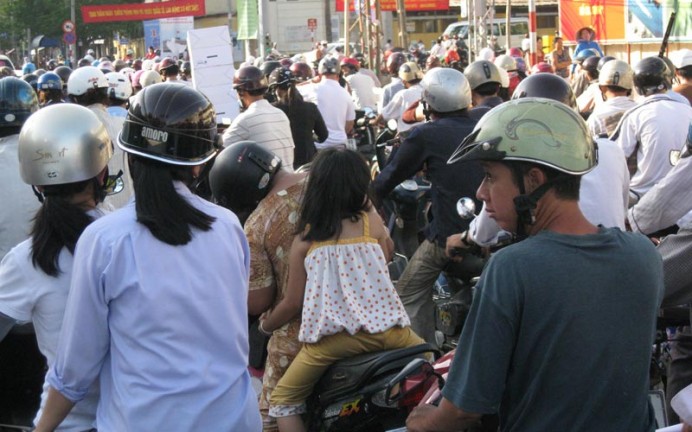
Traffic in Hanoi
It’s a four-hour drive southeast from Hanoi to our jobsite in Thanh Hoa Provence, on roads beginning to show improvement in surface width and quality. I would not tell my life insurance company about the Vietnamese driving habits. This country has more motorbikes per capita than any other. Vietnam competes vigorously with India in obtaining the maximum numbers of horn honks per kilometer driven. Rules of the road and common driver courtesy, as we know them, are nonexistent.
Twin Lakes is to be an executive meeting center, holiday home and resort hotel golf project being promoted by a Vietnamese cement manufacturer. Three design team members – George Philpott and I from Golfplan – Fream, Dale & Ramsey, and Daniel Roos, an architect from Palafox Associates in Manila, tour the lake and kharst limestone outcrop-studded site with Mr. Chinh Leong, the owner’s project director. This is my second reconnaissance visit. The kharst outcrops remind me of Guilin, China. We leave at dusk for a grilled shrimp and calamari meal and a night in a local hotel. After 15.5 hours of flight time, four hours on the road, three hours on site, another hour drive to the surely not five-star hotel, was more than enough.
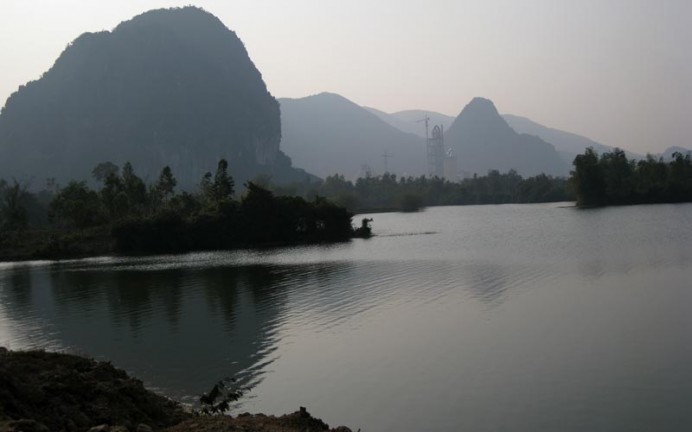
Twin Lakes site
Our group is out early to continue trekking the property. We are determining the land uses to provide a dramatic 18 holes of golf, water-view kharst outcrop hotel site and homes for vacation and holiday use. This development should find eager demand. A four-hour drive from Hanoi is an easy trip for Vietnamese with increasing economic affluence and shiny new cars. While not as crowded as Ho Chi Minh City, Hanoi is densely inhabited. The refuge of tranquil nature is finding an expanding market. The site will prosper.
More space is found to plan for a third nine and hillside, lake and Kharst outcrop views for garden apartments and split-level villas. Another 20 hectares of land might be added later. Having more land now will pay dividends later. Land prices in Vietnam seem high now, but there is no limit over the next few years. Buy what is available.
Fortunately, the humidity is not too intense. When the monsoon returns, so does the humidity. This reconnaissance yields important additional data for refining and elaborating on earlier completed land use studies. Planning will continue as the owners refine their market and goals. It’s time to leave. We are delayed somewhat with late discussions at the site office before a noisy, hectic return drive to the airport. Stuck in traffic, we miss our flight to Ho Chi Minh City. Unfortunately for us, this is a holiday weekend and the only seats available are on a 0230H departure flight. After the airport lounge closes at 2330H, all we can do is sit, nap and wait in the somewhat sparse domestic terminal. This early morning flight is no frills. All we need is sleep.
Ho Chi Minh City is a sprawling mega city of six or seven million people – this density is projected to double in the next 10 years. Arriving at 05:00H puts us at our Saigon riverside hotel by 06:30H with just enough time to shower and meet the first of three clients scheduled for today. A busy day but time at sunset to utilize the rooftop terrace of the Majestic Hotel. A French confection from about 1925, the rooftop terrace offers wonderful views of the Saigon River, bustling ferries and elaborate dinner cruise boats. The continuing noise of horns and motor bikes adds local flavor. This terrace is a people watching lookout.
It’s Sunday morning; we are off early on another four-hour road trip north on the highway towards Hanoi to the nondescript fishing town of Phan Thiet. Good news, fewer trucks are crowding the road, but sadly more locals are out for a Sunday drive. No rules of the road are followed here. The two lane roads serve four or five lanes of vehicles with more than two wheels while two wheelers easily can get 10 abreast.
Mui Ne village, 12 kilometers north of Phan Thiet, is a delightful seaside assemblage of assorted cottage hotels and eating places. Kite-boarders and windsurfers abound as do more and more Russian visitors. Mui Ne also offers an amazing site for golf. Sand dunes, the color of sugar, have piled to some 80 meters above the sapphire blue sea. We run with the site. Golfplan has designed the first course in these dunes. Golfplan always creates one-of-a-kind design, but this giant sandbox offered extreme opportunities. The expressed goal is to produce Asia’s most demanding Scottish Links-inspired championship course. Although Sea Links offers five sets of large diverse tees, this is no place for beginners. Off the back tees, we can stretch to around 6,950 meters (7,600 yards), par 72. Huge rolls of sand undulating and heaving are inspired by the sea. Greens will be immense, offering some three club lengths of variation front to rear. Putting across 65 meters of Tifdwarf Bermudagrass surface with three dissimilar breaks of 50 centimeters and 100 centimeters provide challenge. Every greensite is one of a kind, both frightening and unforgettable.
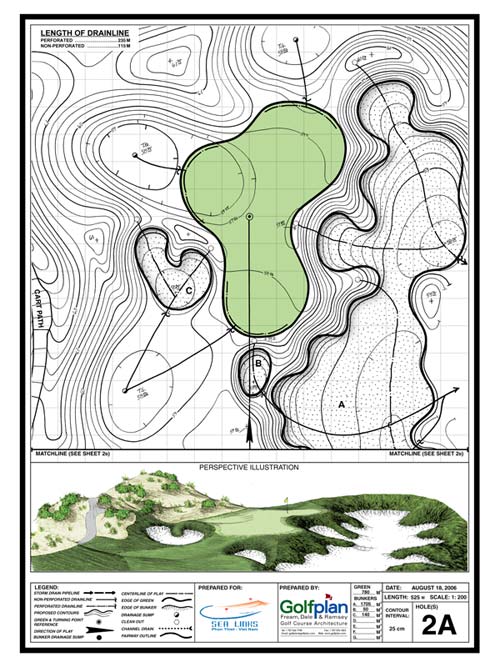
Sea Links green detail
Bunkers only come in large and larger; deep and deeper. The course superintendent was told to take top dressing sand from the bunkers when needed to keep deepening these vast 50-meter and 100-meter long monsters.
Sea Links will be serious golf unlike any other, pushing the edges and stretching the limits of R & A hole length standards, putting eight or even 10 individual flagstick areas on a green. Only the tee tops are flat. Wind off the South China Sea resembles the winds of St. Andrews and Royal Dornoch, only 10 degrees Celsius warmer.

Sea Links sketch
Few places in golf exist where outrageous abandon, aggressive design, and true challenge for the sophisticated player, can be put in place. Come Christmas 2008, news will emerge about this far-out track that is Sea Links. We tour the construction. Dozers push and shape the sand. Seventy or 80 women are planting Paspalum fairway grass. I direct Bill Kessener, our onsite supervisor, “keep things bold, vertical and visual, and, when in doubt, bigger.” When tall Bill cannot see out of a bunker, it is probably deep enough.
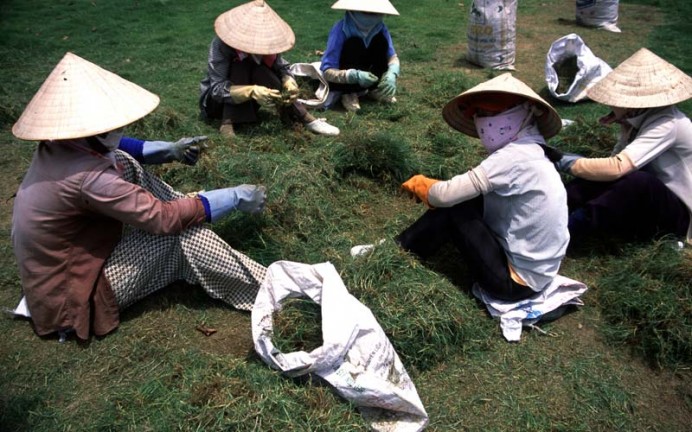
Planting stolons
The next day, out early to face horns honking and ignored driving lanes. This driver honks compulsively. We’re back to Ho Chi Minh City in four and half hours, after an all too-short night in a seaside cottage at Mui Ne. While there, we enjoyed great BBQ ribs, fresh spring rolls, local Saigon beer and balmy breezes. We meet with two Ho Chi Minh City-based clients about pending residential projects. The demand for new residential housing is intense in this market. Daniel is off to the Palafox office in Manila.
George is driven two-hours west to Moc Bai and Bavet, twin villages straddling the Cambodian-Vietnam border where Golfplan is designing the Cambodian-Vietnam Friendship Golf Course. This will be 18 holes, nine playing on each side of the border and the par-5 18th will cross back and forth allowing players to putt to or from Vietnam to Cambodia. While George is gone, I handle administrative tasks at the hotel. Dinner is at a Lebanese restaurant. The lamb kebabs and humus were great. The Australian wine was quite good. George is absorbing both business related matters and new cultural factors as well. The diverse cuisine is a change from his California fast-food rations.
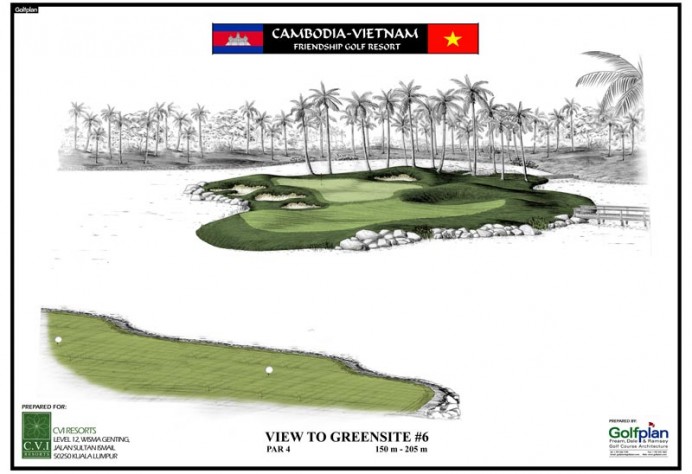
An early morning breakfast of Pho – the wonderful ubiquitous noodle soup – then George transits to Singapore to fly back to San Francisco via an 18-hour Singapore Airlines flight. His first visit to Vietnam is enlightening and educational. I go to Singapore too where a driver waits for the easy road trip over the causeway to Johor Bahru, Malaysia. Singapore roads are like the country itself, smooth, clean, beautifully landscaped, orderly and silent. Johor Bahru is following Singapore’s image as a growing business and residential region.
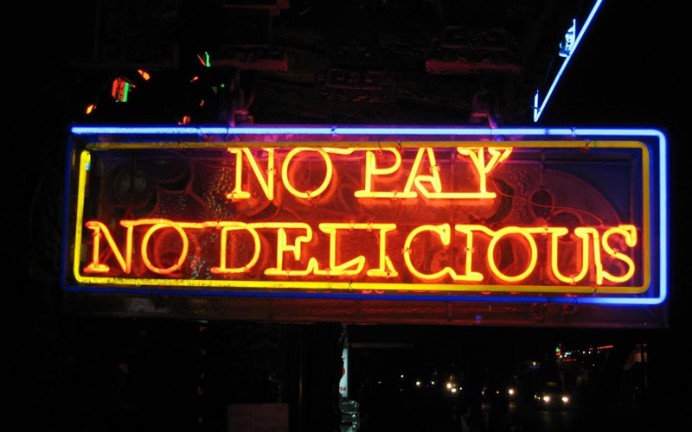 Golfplan is providing consultation for the remodeling and upgrade of Ponderosa Golf Resort in Johor Bahru. Growing real estate values dictate layout changes within this 20 year old course to provide more area for golf-view housing. We also continue with a second project, for the same client, Impian Emas Golf Club. Some 10,000 residences will surround this 27-hole course over the next five years.
Golfplan is providing consultation for the remodeling and upgrade of Ponderosa Golf Resort in Johor Bahru. Growing real estate values dictate layout changes within this 20 year old course to provide more area for golf-view housing. We also continue with a second project, for the same client, Impian Emas Golf Club. Some 10,000 residences will surround this 27-hole course over the next five years.
The next morning, the driver returns and I leave for Singapore Changi Airport again. The causeway immigration control traffic is dense due to a recent security problem in Singapore.
From Johor Bahru, I go to Bangkok. It’s only a 90-minute flight from Singapore to Bangkok. A driver meets me for transport to the Unico Grande golf club not far from the new Suvarnabhumi airport. Site reconnaissance; collect a photo record before sunset and discuss the site’s possibilities before being driven to the owner’s hotel in Bangkok. Too bad this is a quick trip. The all-suite hotel room is stocked with good wine and within an easy walk of a foot massage salon and an eclectic art gallery/restaurant. All in all, I have a relaxing few hours of well earned R & R.
We’re out early the next day for another look-see at the Unico Grande golf course. It’s important to have first hand visual knowledge plus a detailed photo record. This 30-year-old daily-fee course in metro Bangkok does about 60,000 rounds a year. New day, new goal. Tear out golf for a total rebuild including a major sports-recreation-social-golf members’ club. The real focus will be 99 high-luxury golf-view three and four-story condo apartments inspired by the wonderful Aman hotels. Nearing sundown, the driver arrives and it’s back to the airport to relax in the lounge and wait for the next flight.
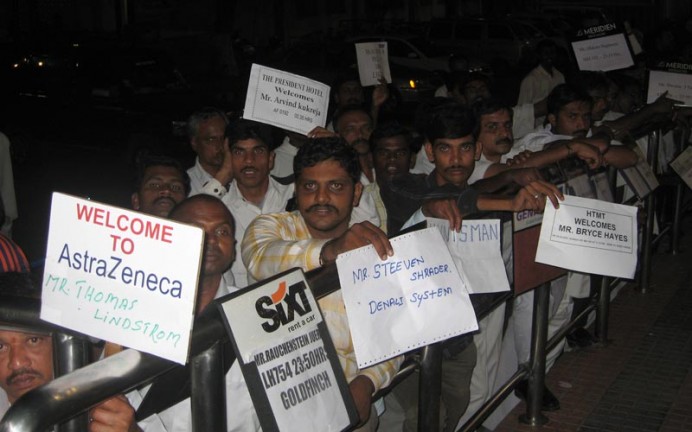
Arrival in Bangalore
It’s a three-hour-forty-five minute Thai Air flight from Bangkok to Bangalore, India’s booming technology city. ETA 2300H. Flight arrivals in Bangalore quickly emphasize the numbers and density of the population. Fortunately, a new airport opens soon. A taxi to the same hotel I have stayed at for years, only the room rates escalate. San Francisco seems cheap, hotel/room-rate-wise. In the basement restaurant, a delicious North Indian menu is on offer when time allows. Incidentally, the local Indian wines are getting better. Out early; after a couple of lengthy strategy and concept meetings on pending Bangalore projects, it’s back to the airport. In much of India, the availability of water decides the fate of many projects. Roads are crowded, horns honking. Dinner at the decrepit airport leaves much to be desired. At 2145H, Jaggu Srinivasan, my long time Indian colleague and I depart for Chennai (formerly Madras) via a 50-minute Kingfisher flight for another late-night arrival. Roads are mostly empty except for the tuktuk drivers, the three-wheel covered taxis, flitting about like dragon flies and honking like a gaggle of geese. Beggars are fewer late at night too.
In Chennai, on Saturday, a site visit for data collection, strategy and planning discussion, crowded roads and thankfully coolish weather. This is “winter” to locals, down to 16 degrees Celsius at night. Unfortunately, 38 degrees Celsius (100 degrees Fahrenheit) plus dense mid-day humidity will soon return. Our dinner at the hotel’s rooftop restaurant rewards the day. Chennai, a teeming city of some 15 million, sprawls below. Now, it’s Sunday and we’re out at 0530H for a 0740H flight departure to Kochi (formerly Cochin).
After a 56-minute Paramount Airways flight to Kochi, we go from the Bay of Bengal to the Arabian Sea.
It’s another hour’s drive south, full of honking horns, through crowded villages, before a cruise on one of the storied “houseboats” of the Backwaters of Kerala. Locals refer to Kerala as “God’s Own Country” – not far off the mark with its long, empty sand beaches; lush, coconut greenery; vast “backwater” lagoons and nine months a year of delightful weather. The three-month wet season is the definition of “monsoon rains”. The houseboats are a major tourist attraction at any time of the year.
Jaggu and I enjoy our leisurely water transport to a 400-acre (162-hectare) coco palm fringed island rice paddy. Talk about a location, not only is the location great; this is the largest parcel under sole ownership with frontage on the Backwaters. With some three kilometers of water edge and large enough for a championship golf course, this true jewel of a site will become a very select, up-market destination resort with luxury homes. Early on, I urged the owner to secure any available adjacent land. With a growing middle class soon to exceed 365 million people, India will create a market demand for whatever we can provide. The owner now sets his sight on acquiring an adjacent 120 acres (48 hectares) currently available, but surely not later. We anticipate 27 lush holes, several waterside hotels, villas, garden apartments and sail-in houseboat moorings. People from the Gulf and up market Indians will pay grandly for large golf and water-front homes here. Tourist golf is new to India but this jewel will speed that activity. The road from Cochin will be upgraded. From the airport, it will be less than an hour.
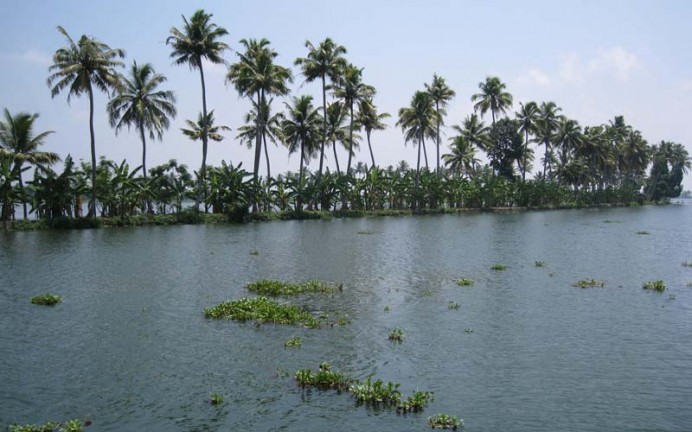
Backwaters site
During the site reconnaissance, it became obvious that we can dredge the one million or so cubic meters of needed fill sand right from the adjacent lagoons. Much of the site is underwater now with recent rice plantings.
After the site reconnaissance, we meet the driver. Returning north to the airport, it is a 54-minute flight from Kochi to Chennai and another taxi to the hotel, arriving just before midnight. Fortunately, Paramount provides a passable in-flight meal. Sleep. Rise early to meet the client again to discuss Sunday’s site visit, before checking out and heading to the airport for a 54-minute flight to Hyderabad, the second technology city of India. The Hyderabad government has surpassed Bangalore in road quality, street cleanliness and general public orderliness. Traffic is still hectic. Horns still honk with the loudest horn usually winning the right-of-way. Bullock carts occasional block the road in this hi-tech outpost. Billboards are everywhere including signs on the walls of many houses, urging Indians to buy things.
Our meeting in Hyderabad is for a new residential golf project to coexist with the growing demand for conferences, family outings and tranquility in the chaos that is overcrowded India. Pragati Meadows is a far-sighted long-established botanical garden with 50 comfortable cottage rooms. Later, 18 rambling parkland golf holes, 150 golf suite rooms and 300 golf-front villa homes will coexist here. The plan is to considerably increase the seminar and conference facilities. The new airport is a convenient 25-minute drive away. Continuing and expanding the botanic garden lushness around the golf is a priority. We will as usual in India utilize a lot of local hand labor in our construction. Labor is cheap and jobs desperately needed.
In the evening, we are en route to Mumbai (formerly Bombay). After the hour flight, the recently upgraded domestic arrival part of the airport is even inviting. Most Indian airports have been among the world’s worst in terminal facilities. Sun and Sand Hotel at Juhu Beach is a refuge. A kebab meal on the terrace overlooking the Arabian Sea belies the filth, poverty, desperation and unending despair of all too-many residents camped out in the Dharavi slum, a teeming area of about one million inhabitants, nearby. Out early with our client, this time to the site of Nirvana Wellness, a large property one or two hours’ drive northeast of the Dharavi slums. Traffic conditions, road accidents and the driver’s ambition influence the travel time.
This dramatic mountain ridge ringed site is a bit desolate in the dry season. Soon, two meters of monsoon rain will change that. One main point is stressed to the owner, “great location and site, buy available adjacent land before unavailable at any price” – my mantra of emerging market golf development. A destination refuge for those fortunate enough to afford a home here set apart from the other 18 million people in Mumbai. Collect site details and take photos. Back to Sun and Sand Hotel for a pleasant seaside Tandori chicken meal in the balmy breeze. The local Grover red wine is quite good.
The next day another early morning check out at 0430H to catch a 0615H flight to Bangalore. After the short 75-minute flight from Mumbai to Bangalore, it’s another two days of meetings regarding our second Bangalore area residential golf project. The roads are crowded and noisy. The beggars are out. Site visits and extensive discussion, including locating the necessary water, with our clients is important. Few Indian developers have prior golf development experience. Providing insight and foresight based upon our 42 years of experience is often an unexpected bonus for them. Having been involved in golf matters in more than 65 countries does produce quite a memory bank of experiences. Hands-on attention is not so common these days.
Working in India always presents the good with the bad, the haves, the really haves and then the have-nots. Tourism in its small way can help change lives. With about 700 million inhabitants existing on the equivalent of US$2 per day (sometimes less) anything our efforts can do to create jobs can improve economic conditions for the have-nots is surely useful. Promoting open-to-the-public, daily-fee and tourist-access golf has a higher spin-off value than exclusionary members’ only private clubs.
March 14th. Leaving Bangalore Airport is always a treat. Soon, a new modern airport will thankfully replace the overcrowded terminal serving this city of some six million. The nearly four-hour Malaysian Air flight to Kuala Lumpur departs just after midnight on the 15th and arrives at sunrise. Kuala Lumpur is a booming city. Indirectly influenced by Singapore, the city boasts many modern and distinctive features. Great roads, orderly drivers and an absence of horn honking is quickly noted. Bad news in. Reports of discontent in Lhasa, Tibet. My plans to go to Lhasa in a few weeks are postponed indefinitely. Kuala Lumpur on the 16th is a birthday dinner with Yoko at a fine Thai restaurant with South African Pinotage wine. Nice.
Monday morning finds me on the early 41-minute shuttle flight from Kuala Lumpur to Singapore for continuing meetings at Singapore Island Country Club (SICC). Golfplan is to direct renovation and upgrading of the nearly 70-year-old Bukit and Sime courses, two of SICC’s four 18-hole tracks. With more than 17,000 social, corporate and golf members, SICC is a major social and political influence in Singapore. After day-long meetings that ran into the night, it’s another early morning flight to Ho Chi Minh City, only one and half hours in the air. Catching the FT and IHT papers in Singapore elaborate upon the trauma of Tibet. I had expected to return in late March or early April to follow-up my tour of last October. Tourist golf in Lhasa is feasible climatically, so long as peace and tranquility encourage intrepid adventure-seeking golfers. To do golf here on the roof of the world be great fun.
At the new Ho Chi Minh International airport, a driver waits. Horns and traffic again all the way to Sea Links at Mui Ne. The trip is pushing five hours with heavy, chaotic road traffic. It’s time to meet about a possible new 18-hole seaside sand dune site resort 15 kilometers north. Some aspiring developers do not appreciate the potentials and opportunities of unending waves of sugary white sand piled high above a brilliant blue sea. Could this site be good for golf? Certainly! Can you grow grass on this sand? Sure! You only need water, creative planning, innovative design and agronomic technology, in that order.
Construction at Sea Links continues. This must be my 10th or 11th visit to review progress on greensite and fairway contour shaping. Two steps ahead, one step back as the owner’s well-intentioned project manager continues to make uneducated decisions relying solely on his own judgment. Bill Kessener, Golfplan’s site supervisor, prevails as best he can. The bunkers stay deep; the turf is being mown, more or less. It’s sundown, a cottage by the sea and dinner. The grilled tiger prawns were great. An Australian Chardonnay compliments the huge shrimp. Starting early in the morning, it’s another four-hour drive back to Ho Chi Minh City. I have learned to use these trips on the road to Mui Ne to catch-up on some sleep or prepare for the next meeting. Later in the day, while viewing the sunset and river life from the rooftop terrace of the Majestic Hotel, there’s some time to relax. Dinner tonight will be either Indian or local street stall.
The next morning after a bowl of Pho with beef, it is an easy two-hour flight from Ho Chi Minh City to Manila for a visit to long-established Wack Wack Golf Club to familiarize myself with a much needed refurbishment, tour and discuss what is possible and desired. Fewer horns but the traffic is just as crazy, only with many Jeepney taxis. A three-hour evening flight to Singapore. At least, SQ serves a good meal and good wine. Another taxi ride back to the Traders Hotel, a businessman’s hotel off the main street. The small adjacent mall is a restocking destination. Hotel rates in Singapore seem to be influenced by those in India; two options – high and higher.
Next morning, my Thai flight is to Kathmandu from Singapore via Bangkok. Thai service is nearly as good as on Singapore Air. About five hours total flying time and, with a right side window seat, I am hoping for a view of Mt. Everest and much of the Himalayan Range on the way in. Pre-monsoon clouds block only some of the view. The Summit of Everest can be seen, defined by the prominent plume of ice crystals. The Himalayan massif is an amazing geographic feature. Nepal has eight of the world’s 12 8,000-meter peaks. I have seen all eight, plus two more in Tibet and Pakistan.
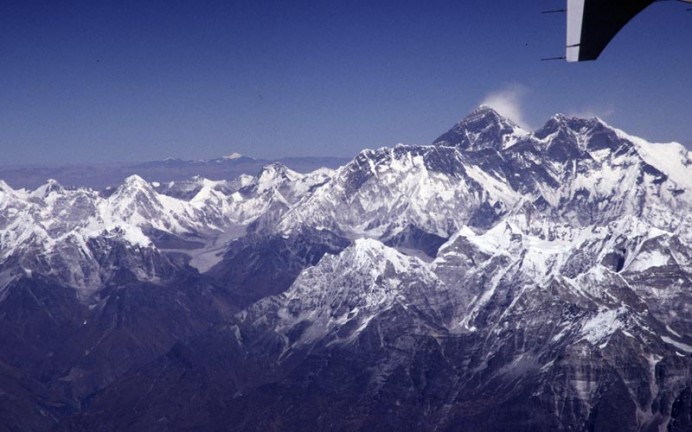
Mount Everest
I visit Nepal frequently. My initial visit back in 1977 or 1978 for U.S. AID opened up the majesty of the high mountains and the fascinating appeal of the Nepalese culture, people and architecture. Years later, a trek with my daughter Angela to Mt. Everest South Face base camp provided more appreciation. For too long, inept, self-serving politicians have done nothing for the country. The egocentric king lacking compassion for the local villagers was deserving of no credit or support. The Maoists who have terrorized the nation for 10 years are finally willing to talk. Their positions are not so extreme – only contrary to the too-long in place establishment pro monarchy politicians. The recent election sets the stage for peace and progress. Hopefully, some tranquility and stability follow. I am happy to note the more recent dethronement of the now former king. This is a progressive step toward some form of democracy and much needed economic growth.

Communist art
What has been Royal Nepal Golf Club is the original course in Kathmandu. When I first visited, this course was mostly sand greens playing over cattle, sheep and goat tracks. This was a classic hand-made course, rough and rugged. Airport expansion removed the really unique old holes. The new course is nearby but now of more common character. Offering pro-bono Golfplan consultation to Ghana Shyam Thapa, pro/manager at Tribhuvan Army Officers Golf Club and Gokarna Forest Golf in Kathmandu and the amazing time warp Himalayan and Yeti courses at Pokhara in the shadow of the Annapurna massif is our way to try and rehabilitate the country’s golf tourism potential. These five courses in Nepal are individually unique and well worth a golfing tourists visit. With a peaceful government, tourists and trekkers will return. The country will greatly benefit economically from increasing tourism.
Trekking the streets of Thamel-Kathmandu, Bhaktapur and Bodanath presents historic and ancient architecture and world-class people watching with rickshaws vying with motorbikes and too many cars on too small roads. Tibetan refugees test the army and police near the Chinese Embassy. Poor and ill people seek compassion and financial aid along the streets. This raw poverty can be very disturbing to me. I have found that when I offer to “buy” a street person’s picture they are more willing to agree. I have accumulated a series of people and poverty photos that are uncomfortable to look at. Giving cash, in excess of the daily wage equivalent, helps some of these unfortunates afford a better meal or a cleaner place to sleep. Streets crowded with the poor and needy are unfortunately found beyond Nepal. A social safety net is lacking. Too often, local awareness of the ills and misfortunes afflicting their own fellow citizens is lacking.
The historic architecture with its impressive form is fortunately protected in some locations. Uncontrolled residential growth in the Kathmandu Valley has pushed out the rice paddies. Traffic is often gridlocked. Even peaceful politics cannot solve Kathmandu’s dense population induced problems.
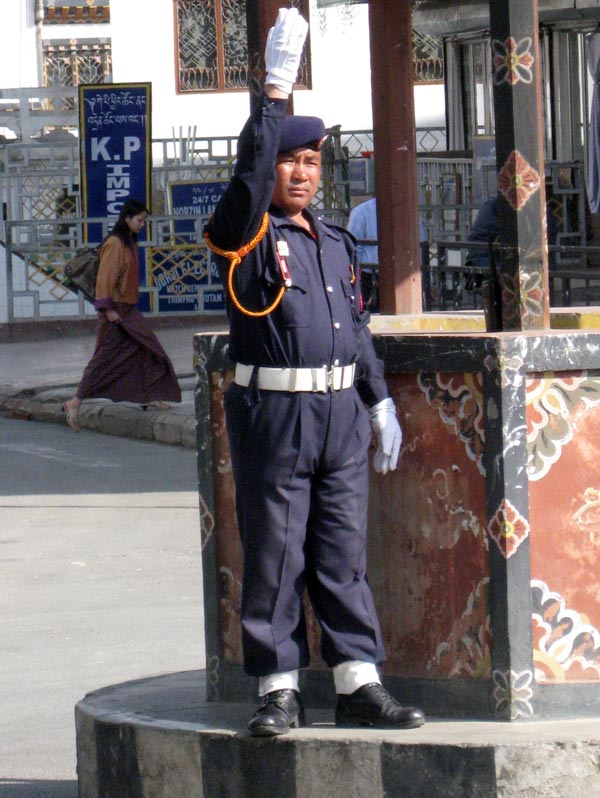
Traffic control
The Rum Doodle restaurant in Thamel, the touristy action area of Kathmandu, is the place to see the world’s largest collection of Mt. Everest trek and summit memorabilia, legendary climbers’ autographs and Himalayan graffiti. Dinner on the roof in the mild weather is always enjoyable.
Sunday leaves crowded and evermore dirty Kathmandu behind. Druk Air flight 203 heads east to Paro; unfortunately, monsoon clouds are bold and high. Much of the Himalayan Range is hidden with only wispy hints of Everest’s summit (8,848 meters, 29,028 feet) and part of Kangchenjunga (8,586 meters, 28,169 feet) in view. Paro is the only airport gate way to Bhutan. It’s a 56-minute flight and vast differences from Nepal.
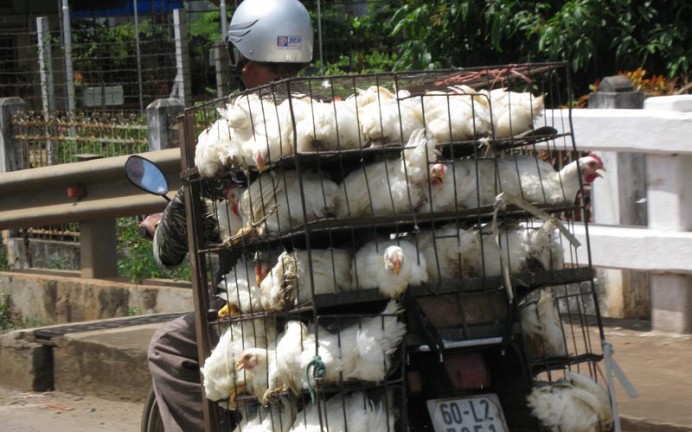
The crowded streets of Nepal
Nepal is overcrowded, some 20 million residents – too many of them young, uneducated and unemployed. Kathmandu has surged from 400,000 residents 20 years ago to two or three million, or more. Roads, water supply, sewers, electricity, and housing have simply not kept pace. Deforestation is rampant resulting in extreme monsoon erosion. By contrast, Bhutan is a time warp of nature, culture, one-of-a-kind architecture, history, and dress. More than 75 percent of Bhutanese forest is protected. Even trekking and climbing to the 6,000 and 7,000-meter Himalayan peaks along the Chinese border are closed to people so that the gods living there are not disturbed. The Bhutanese prefer to protect these abodes of the gods than earn mountain climbing expedition income.
The road from Paro to Thimphu, Bhutan’s capitol is a joy to behold. Much of the one-hour drive is along well-constructed macadamized surfaces. A year ago, this was a dirt track clutter of in-place rock blasting, sledgehammers to rock, grading, and paving efforts. Trucks still hog the road but horn honking is lessened. There are no traffic stoplights in Bhutan. Only one traffic control point in Thimphu exists, consisting of one or two white-gloved traffic control offers on a podium at the main road junction of the city. One main street, few motorbikes, lots of walkers and minibus taxis. Thimphu with its approximate 100,000 residents is the smallest national capital in the world. This mini-city is at about 2,400-meters altitude surrounded by 3,500-meter ridges with peaks towering beyond 6,000 meters to the north. There are only about 600,000 inhabitants in this Buddhist kingdom. The monarchy has been considerate and benevolent – truly caring for its citizens. The King’s main goal has been gross national happiness, not gross national product. This is a stark contrast to the situation in Nepal.
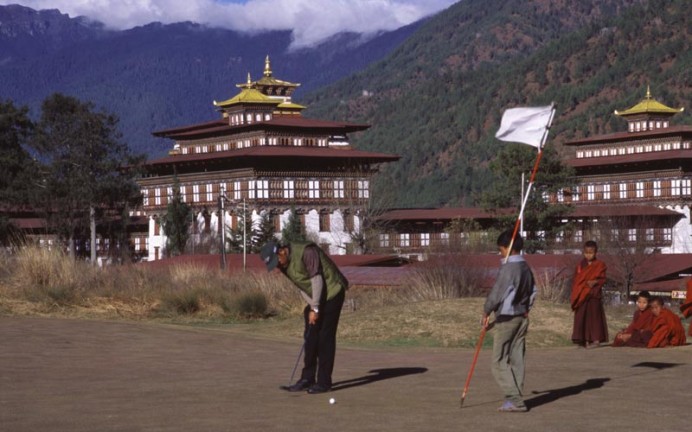
Royal Thimphu
The nine-hole Royal Thimphu Golf Club is modestly maintained but rustic and scenic golf. Multiple tees provide for nine more holes. Sitting adjacent to the course is the main dzong, or fortress of the city, which houses the king’s official offices and the home of the primary Buddhist monk, who oversees religious activities in this devotedly Buddhist country. Many Buddhist monasteries are found across the country. Long tranquil, no demonstrations against the ongoing Tibetan carnage just over the Himalayan ridges have occurred. Access to Bhutan has been restricted. Tourism entries have been limited to less than 12,000 per year, but recently raised to around 18,000. High-value tourists are encouraged while low-budget backpackers cannot get entry visas. Restaurants are few, but the Chinese, Indian and local cuisine is appealing. The local beer – Red Panda – is quite good, too. The shoddy tourist shops found in Kathmandu are absent here.

A good drop!
The Indian Embassy compound has a homemade nine holes. The King’s Bodyguard Detachment has also built a rump nine-hole course for their recreation. Some four hours’ drive easterly, at Punakha, an army base also has a form of nine holes. This is it for golf in Bhutan with only the RTGC open to visitors.
I am having a look-see into ongoing operations at the Bhutan Youth Golf Association (BYGA), a primarily US-funded non-profit group conceived by Rick Lipsey, a New York based journalist, bringing golf teaching and golf play to the countries young people. Royal Thimphu Golf Club kindly permits our children to periodically utilize the facilities. As a board member, I am meeting with Mr. Karma Lam Dorji, a Ministry of Youth and Sports employee and our local representative. Karma provides much appreciated guidance and instruction as well.
With the generous assistance of the Royal & Ancient Golf Club Golf Development Fund in St. Andrews, BYGA has recently received 50 TaylorMade youth club sets and 50 kilograms of used golf balls. These gifts are a joy and incentive for the ongoing growth and success of the BYGA in Bhutan. Usually, American teaching pros travel to Thimphu several times a year for a two or three-month duration. About 60 boys and girls, from 6 to 16, participate in lessons and competitive events. Some of our students will stand out in Asian competitions one day. These are not Tiger Woods Foundation or First Tee level programs but they do help grow golf. Now, I am helping to organize a similar program in Kathmandu.
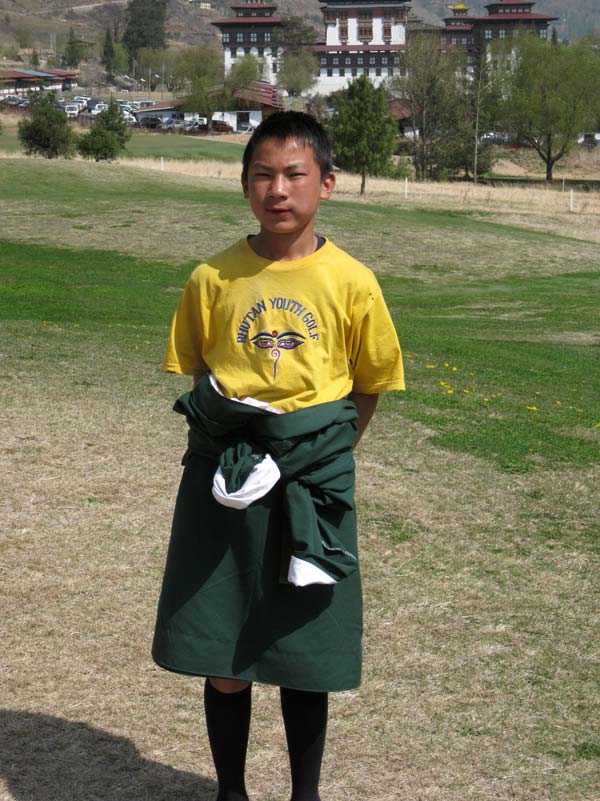
Bhutan Youth Golf
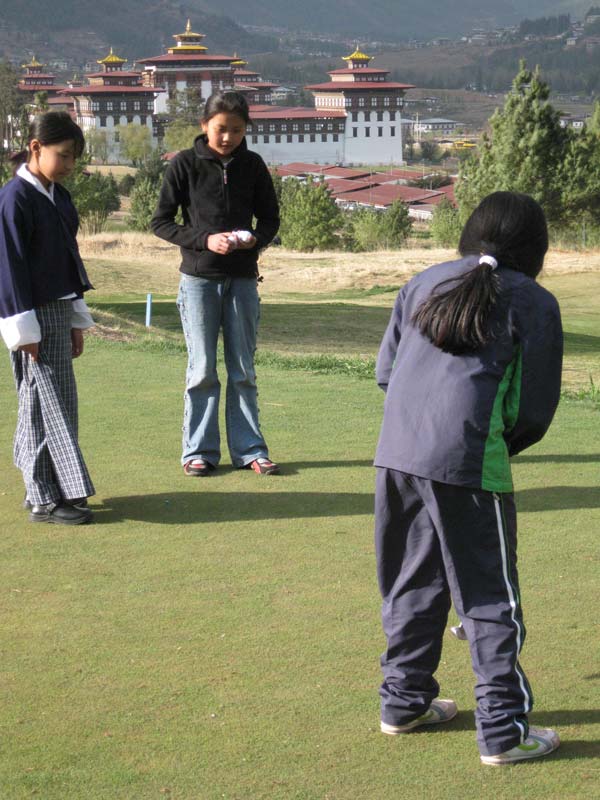
The spirit of golf is alive and well in Bhutan!
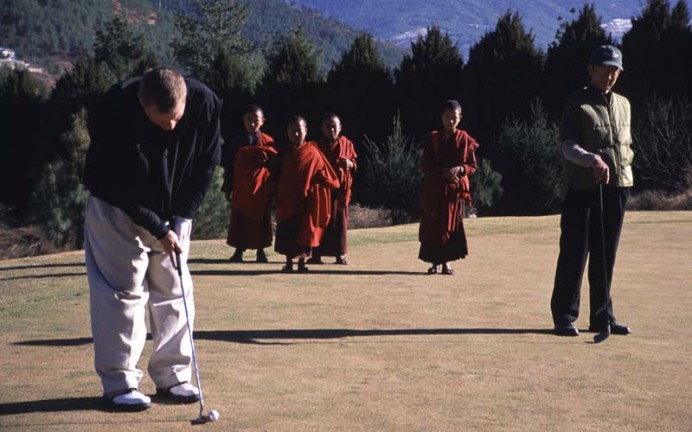
The game attracts some spectators.
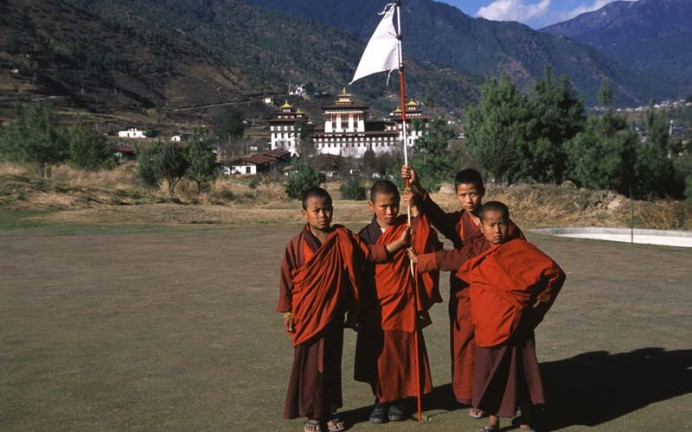
Young monks
Royal Thimphu Golf Club contacted the R & A seeking some financial support to upgrade the course. Income at the course is modest. Through Golfplan, I have provided guidance and “what-if” line items to relocate bunkers, add or shift tees, remove blind or unfair hazards and generally try – with a small budget – to noticeably improve the course. No room to expand the course or extend tees exists as the city has fully encroached upon each boundary. Budget limitations restrict any thought of rebuilding greens now. The club and R & A, along with my “what-if” list, will reconcile the scope of works. I will find a way to put in some time helping implement the work. The club members are enthusiastic and want to make more of their course. The current BYGA teacher, David Havens, has experience in construction and turf maintenance. His onsite presence and enthusiasm will expedite our upgrading efforts. David has found space to create a small short game practice area too.
BYGA will also benefit as a condition of the R & A helping upgrade Royal Thimphu. The club has increased access to the course for the 60 or so students who participate in the BYGA program. The club also agreed to liberalize the availability to the course of graduates of the program when they reach the age of 16
There never seems to be enough time. On the road again.
It’s Friday, April 4. Leaving Paro for Phuket Island, Thailand via Calcutta and Bangkok, the departure flight was delayed due to local weather. The landing and takeoff at Paro is one of the world’s more exotic due to the in-the-valley, below the ridge winding approach and take off. It takes three flights of nearly four hours flying time to reach Phuket.
Yoko arrived in Phuket from Kuala Lumpur ahead of me, due to my several hours delay. The hotel driver delivered her comfortably to the Amanpuri, the flagship of the ultra-boutique Aman Resorts. I caught a taxi and reached the hotel in time for a late evening pool terrace gin and tonic and a delightful poolside meal of Thai green curry chicken with a Cape Town-area Pinotage.
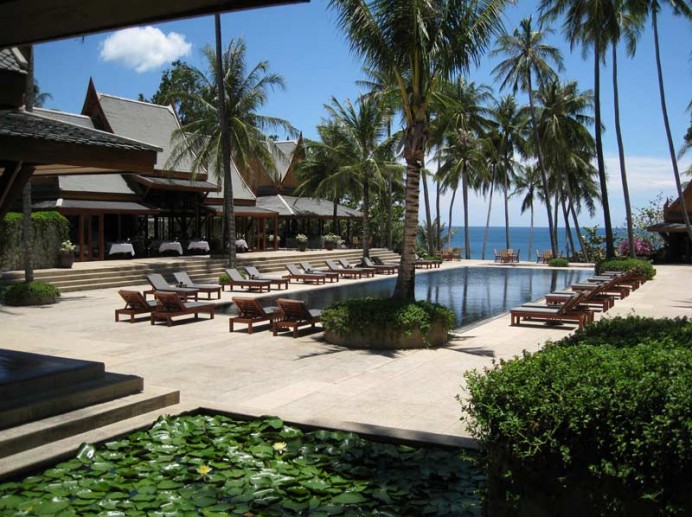
Amanpuri Hotel
The meetings at Amanpuri involved the concept and direction regarding the Unico Grande golf course at Bangkok I had visited two weeks earlier. Adrian Zecha conceived and founded the Aman Resorts Group. At 75, he is still the creative and visionary force. While discussing the scope of the Bangkok project, I mentioned our fundraising with the R & A to upgrade the Royal Thimphu Golf Club. Five singularly unique Aman hotels are now in Bhutan with a sixth in construction. Adrian proposed matching the R&A development funds if the club would host an annual “Aman Cup” event. I jumped at this generosity. The realization of an Aman Villa Golf project in Bangkok and an Aman Cup at Royal Thimphu were major accomplishments.
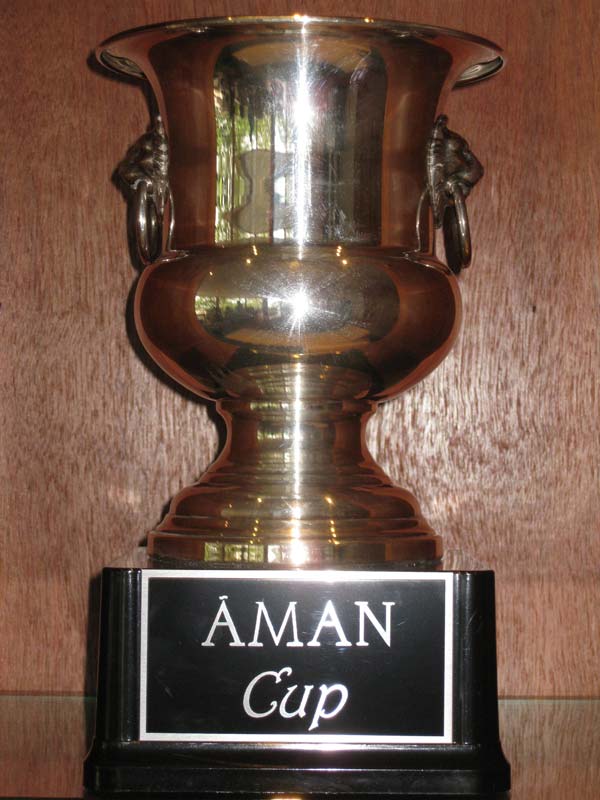 After Aman, Yoko heads back to Kuala Lumpur and I am off to Kochi (Cochin), India via Singapore, six hours flying time. A night arrival and an early morning out, this time I am off with Jun Palafox, a widely experienced planner and architect from Manila, Capt. Dhillon, the owner’s project director and Jaggu Srinivasan to revisit the Kumarakon Lake Backwater site. An hour on the road and another tranquil cruise on a handmade bamboo thatched boat. This one had only two suites. Some of these houseboats have three, four or even five suites.
After Aman, Yoko heads back to Kuala Lumpur and I am off to Kochi (Cochin), India via Singapore, six hours flying time. A night arrival and an early morning out, this time I am off with Jun Palafox, a widely experienced planner and architect from Manila, Capt. Dhillon, the owner’s project director and Jaggu Srinivasan to revisit the Kumarakon Lake Backwater site. An hour on the road and another tranquil cruise on a handmade bamboo thatched boat. This one had only two suites. Some of these houseboats have three, four or even five suites.
After weeks on the road, the backwater site is still as appealing as when I first visited. The owners followed my suggestion to buy as much as they could. Another 120 acres (48 hectares) are available, for a total of 520 acres (210 hectares). More importantly, I had learned from Adrian Zecha he already had plans for an Aman boutique hotel in the Fort Cochin historic area. Having a lagoon backwater site with golf for another Aman was of interest to him.
The site tour and planning discussions over, it’s back to the airport for a late evening overnight flight to Singapore and an early morning connecting flight to Kuala Lumpur. The KL Express train is a comfortable non-stop train to and from central Kuala Lumpur to Kuala Lumpur International Airport (KLIA).
A day site visit to Emerald Township north of Kuala Lumpur was next. Emerald is primarily a mid price housing estate with some 2000 homesites. Our golf is what I call a boutique course, nine diverse holes with ample greensite area for two flags. The compact course will offer challenge, scenic parkland open-space beauty and encourage family use.
Saujana Hotel and Resort near Kuala Lumpur offers 36 scenic holes, the Palm Course and the only slightly less demanding Bunga Raya 18. Golfplan provided the original planning and design for both in 1979-1981. What dramatic changes have occurred around Kuala Lumpur since I first came here in 1976 for the Genting Highlands project. The Palm 18 – also know, for good reason, as “the Cobra” – has hosted some 10 Malaysian Opens plus numerous other prestigious national and international events. I must again review the present layout and add to my notes regarding the pending remodeling.

Time and success have clearly taken their toll on the track. When originally designed, no one would have suggested 60,000 member and guest rounds a year. Heavy play has helped homogenize the course. “Green Creep” and “Bunker Creep” have inevitably imposed their moderating effect. Golfplan has been engaged to rebuild and refresh this course to new international competition standards. The work will renew and revitalize while retaining the historic oil palm plantation ambience. Saujana Palm was the first golf course created fully within an oil palm plantation.
After Saujana, it was KLIA back to Ho Chi Minh City to meet a new Vietnamese client with a large parcel southeast of the city in the projected growth region. Our meeting and site tour left me with a good mental image of the experience reaching the area and the surroundings. Knowing the site, even if much is a flat rice paddy, helps with conceptual land-use planning. A large number of ancient graves were not on the topographic plans but are cause for due consideration. We will study the property to layout 27 holes with a diverse selection of single and multi-family mid-priced housing. Through frantic traffic back to the city. Majestic Hotel terrace at sunset. La Forchette bistro around the corner provided dinner. French merlot complimented the Salade Payseanne and beef bourguignon meal.
Friday morning, noisy taxi and then its Singapore Airlines, and a 90-minute flight back to Singapore. A membership meeting is upcoming Saturday night at Singapore Island Country Club (SICC). David Dale and Kevin Ramsey have flown from our Santa Rosa, California office to help me cover all aspects of Golfplan service. Rick Kroeger, our consulting agronomist is here too. We participate in extended meetings. That night its public relations and Q&A time for an extraordinary general membership meeting. This is to define the why, how and how much to renew these two distinguished courses. The original Bukit Course dates from the 1920’s. Four hours of public meetings and explanations followed some three hours of redevelopment committee discussions. Works begin in a few months, starting with nine holes of the Sime Course. Protecting nearly 100-year-old specimen trees, respecting the original James Braid design influence on the Bukit Course and caring for the environmental concerns of golf water runoff into an adjacent Singapore domestic water reservoir are part of the design challenge. Costs to build golf in Singapore now are astronomical. Obtaining suitable sand is a challenge. We may have to barge sand from Vietnam.
A quick car trip across the causeway the next morning takes me back to Johor Bahru, the booming southern city of Malaysia. In spite of some Malay apprehension, Johor is the emerging up-market residential suburb for the economic dynamo that is Singapore.
Ponderosa Golf Club is a work-in-progress remodeling and upgrade. Golfplan has had a hand here for some four years. In that time, the economic and real estate demographics have expanded greatly. At the direction of Frank Goon, the projects CEO, we have drawn and redrawn golf hole plans, shifted and rebuilt holes to carve out more and better homesites. Periodic site visits confirm the quality construction methods of Alex Liew and his team. We are using a locally produced mutant variety of Tifdwarf Bermudagrass on the greens that is of a finer texture and more intense green than the original.
Impian Emas Golf, set on a large plot, is a sister course to Ponderosa. Over some years about 10,000 homes will be built here by Berinda Bhd, a member of the Kuok-Shangri-La Hotel Group. At Impian Emas, we have completed a tough, scenic nine holes. Over the course of some three years, the area for the next two nines has been massaged, adjusted and now partially relocated as the real estate market has expanded. Styles of homes on sale four years ago are no longer suitable. Larger, more elaborate villa and duplex offerings suggest the increasing sophistication and wealth of the area. Creatively-designed multi-story terrace garden apartments are a growth segment too. Maximizing golf views is a priority. Consultative meetings periodically review the market and define our design solutions. Our client here has come to expect frequent meetings. Construction in the second nine will start late this year. I overnight at the 10-room “hotel” next to the Ponderosa clubhouse.
A taxi at 0530H to Singapore finds the causeway border crossing congested. The Singapore Airline Lounge is an unsurpassed refuge. The almost three-hour flight to Hanoi is uneventful. Meeting with Mr. Vo Dien Bien is always interesting. Bien has his sights set on several Vietnamese beach areas. Golfplan has provided the preliminary concept land-use and golf designs. Bien has recently been in Cuba researching the emerging Cuban tourist market. Always in my mind is Bien’s father, General Vo Nguyen Giap, a person the US Military was not happy with during the Vietnam War. The Cubans welcome Bien with enthusiasm. Dinner at Guan An Ngon is a wonderful Vietnamese meal of spring rolls and baby back rib BBQ with an Australian wine under the balmy sky.
In the morning, it’s off to another meeting in Ho Chi Minh, a one-and-a-half-hour flight, and I’m back to the Majestic Hotel. The Majestic always offers great terrace views to the hustle and bustle of the Saigon River life. As has been noted, gin and tonic here at sunset is a people-watcher’s dream. A bowl of Pho with shrimp and beef from the stall down the street can do for dinner.
 The next morning, I am back to Kuala Lumpur via a one-and-a-half hour flight and the KL Express for a return to the Saujana Resort for more site reconnaissance and a series of strategy meetings. Early “what-if” concepts are presented to the chairman and the board. More elaboration and consideration will occur before the detailed final remodeling design will be recreated as working drawings. No decision has been made yet whether to remodel all 18 holes at once or commence nine holes at a time over a longer period. Yoko joins us for dinner at the Italian restaurant in the Saujana hotel. The bottle of Sangiovese red was very nice.
The next morning, I am back to Kuala Lumpur via a one-and-a-half hour flight and the KL Express for a return to the Saujana Resort for more site reconnaissance and a series of strategy meetings. Early “what-if” concepts are presented to the chairman and the board. More elaboration and consideration will occur before the detailed final remodeling design will be recreated as working drawings. No decision has been made yet whether to remodel all 18 holes at once or commence nine holes at a time over a longer period. Yoko joins us for dinner at the Italian restaurant in the Saujana hotel. The bottle of Sangiovese red was very nice.
Tickets are obtained for a long homeward run via Johannesburg, South Africa, a 10-and-half hour flight, on a comfortable Malaysian Air 777, with tickets onward to Sao Paulo. But wait, at the last minute, while in Joburg, meetings in Brazil must be postponed for some weeks due to unexpected events. I change direction, reconfirm a new meeting. The next day, I’m off to Entebbe, Uganda, only a leisurely four hours from Johannesburg via South African Airways. A window seat was not beneficial as much of Africa was under cloud cover. As we prepared to land, there was a spectacular view of the sunset across Lake Victoria. Entebbe Airport and the arrival hall are newly upgraded. Visa on arrival is easily done for all of US$50. It is 2000H and dark. The client’s driver meets me. The views along the way are obscured accept for the intense social activity along the road. Battery lights, cook fires, roadside stalls, clusters of people and auto traffic but a complete absence of horns during the 30-minute drive.
The five-star Kampala Serena Hotel is a pleasant welcome. The lobby, halls and my room are stocked with local artwork, handicrafts, weavings and other comforting traditional décor. This is not merely another five-star generic hotel. The 1.5 meter tall crested cranes nesting in the trees outside the hotel are quite a treat to watch.
The client is a construction firm with long activity in Uganda and Kenya. Road building, hotel construction and civil works join with ready-mix cement, tile and brick production, aggregate mines and emerging tourist resort business.
The Uganda Golf Club in the center of Kampala is another British inspired nearly 100 year old golf club. The course reflects its British engineering origins and its age. This remains primarily a members’ club and is not heavily used.
Ranch on the Lake Resort is 15 kilometers from Kampala, but feels farther away. The current rough and dusty road through ramshackle hut villages will see upgrading before long. The nicely done cottage hotel soon will be joined by an adjacent 125-room deluxe addition; the Citadel. The setting can work as an East Africa fly-in executive meeting center. Some existing public space areas will go down as the new hotel expands. More than 60 quarter acre (1,000 meter2) villa home site lots are being developed. This hillside development will have full southern and western exposure to the golf and to Lake Victoria. Simply put, this resort is overlooking one of the most historic bodies of water in the world. The huge lake is over 300 kilometers north to south and covers about 68,800 square kilometers (26,560 square miles).
Our early planning discussions include how we can excavate, reshape and enlarge portions of the lake edge. Bringing Lake Victoria into our layout design is essential. The indigenous Papyrus shrubbery and Lake Victoria stretching into the vast distance are two special design features to use. We will also create space for about 20 additional villa sites. Helping keep the project financially sound is important.
A dramatic lakeside, lake-front island 18th green in Lake Victoria can be created here. Some areas will need to be dredged and raised. Papyrus shrubs grow to three meters high and will present a natural rough. Kampala is a series of well-treed hills at around1200 meters altitude just 34 kilometers north of the equator. The surface of Lake Victoria is 1,134 meters. Our golf course will be a few meters above the lake level. Raising golf holes even three or four meters will present longer views south toward this vast blue expanse of water.
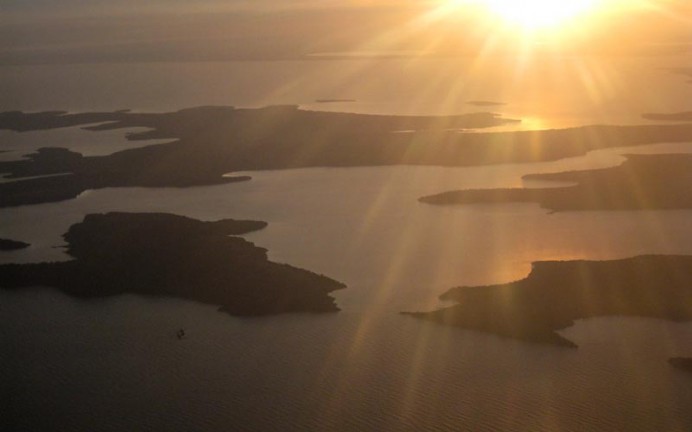
Sunset over Lake Victoria.
A marina is being designed adjacent to the golf. A joint sail-in marina club, golf club and fine dining tourist restaurant will be provided for locals and tourists. A members’ only area in the golf clubhouse will offer exclusivity. We look to 6,725 meters (7,350 yards) or so of proper championship length due to the altitude and low humidity of the site. Par will be 72. Creeping bentgrass can do nicely on the greens in the mild, never-hot climate. Paspalum will likely be our fairway turf. The golf layout must address ways to enhance the value and marketability of the adjacent villas. The Citadel, the new hotel expansion, will have direct views on to the golf and Lake Victoria. Boutique shops and a café will front the marina. Lake Victoria Golf and Sailing Club will be a special place.
Next day, Tuesday, May 6, Mukasa Lugenwa drives me east to the quaint lakeside town of Jinja. The one-hour trip provides a view of vast tropical forest, sugar cane and tea production along the way. Sugar is a major cash crop. The main traffic is trucks to and from Kenya. Jinja, situated at the shore of Lake Victoria, is ready for a tourist-inspired facelift and upgrade. In 1862, after a long search, British Explorer John Henning Speke strode to the edge of a bluff and saw, for a European’s first time, the source of the Nile. Ripon Falls originally defined the outfall source. Speke named the falls for the then-president of the British Geographical Society. In 1954, Owens Falls Dam, a few kilometers downstream, began producing electricity. The Ripon Falls were flooded and are only a small ripple now. These headwaters of the Nile are some 6,400 kilometers (3,976 miles) south from the river’s outfall at Alexandria, Egypt.
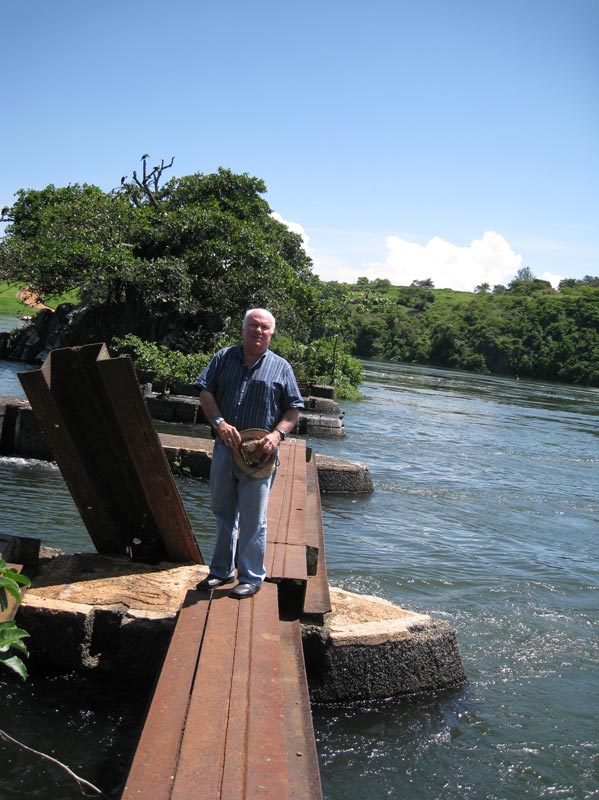
Ron Fream on the Nile.
Standing at the edge of Ripon Falls, gazing across the expanse of Lake Victoria was an indescribable event. Mukasa and I enjoy drinking a Nile Special beer at the source of the Nile. A brewery just down the river near the Owens Falls Dam produced the beer. The Nile River water in the bottle of beer is of rather better quality than the Nile waters at Cairo or Alexandria.
Since 1972 with Golfplan, I have helped introduce golf in distant places. Uganda is the 67th country I have visited for golf, 125 countries in all. Based on my experience, I believe Uganda has huge long-term potential with tourism focused on natural beauty, forest reserves, game parks, culture and golf. European winter season golf could be a real market focus. Utilizing the banks of the Nile River, the shore of Lake Kyoga between Lake Victoria and Lake Albert for golf resorts would be world class stuff. Our site on Lake Victoria is pretty spectacular itself. Golf in one of the game parks could rival these similar combinations in South Africa. Uganda and Kenya could join to promote East African safari golf. Tourism can be environmentally compatible. Tourism creates many jobs. Employment counters poverty and desperation.
After Jinja, it was dinner in Kampala and a short drive to the Entebbe airport to make a Tuesday evening departure. It’s an eight-hour flight on KLM from Entebbe to Amsterdam overnight. San Francisco is another 10 hours away. Finally, arriving in the “City by the Bay” ends a 76-day, 41-flight trip (and my 43rd Ëœround-the-world’ in 42 years of being a golf architect). Elapsed total flying time is approximately 107 hours, which roughly translates into around 75,000 kilometers (47,000 miles) of air flight for this trip. The airport shuttle bus to Santa Rosa takes just under two hours.
After some 3,000 flights and around seven million kilometers (4,350,000 miles) of air travel since 1966, it’s still fun to find new things at the end of a flight. The challenge, the diversity of sites, locations and clients bring great invigoration and enthusiasm to this demanding schedule. Travel to provide direct and hands-on attention; staying with clients beyond the “photo op” to truly learn about the site and understand the clients’ goals produces lasting, economically-viable results. Seeing lasting changes, creative or even innovative results and results complimentary to their environment and social place is a reward for me.
Hindsight and decades of experience clearly brings home the benefits that emerge from tourist golf development. Not only do golfers benefit. In emerging markets, job production is one of the most basic ways to overcome poverty and fundamentalism pursuits. Employment enhances self worth and accommodates aspirations. Calculating how many jobs – directly and indirectly – that has emerged from Golfplan’s 155 completed projects around the world is impossible. The great satisfaction received in contributing to the process is enough.
The End








